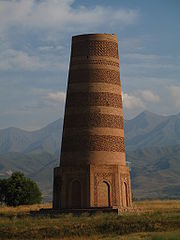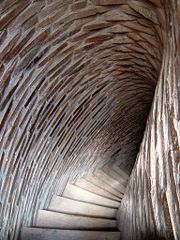
Burana Tower
Encyclopedia

Minaret
A minaret مناره , sometimes مئذنه) is a distinctive architectural feature of Islamic mosques, generally a tall spire with an onion-shaped or conical crown, usually either free standing or taller than any associated support structure. The basic form of a minaret includes a base, shaft, and gallery....
in the Chuy Valley
Chuy Valley
The Chuy Valley is a large valley located in north Tian-Shan. It extends from Boom Gorge in the east to Moyun-Kum desert in the west. It borders Kyrgyz Ala-Too in the south, and Chu-Ili mountains in the north. Through Boom Gorge in the narrow east part Chuy Valley is linked with Issyk-Kul Valley...
in northern Kyrgyzstan
Kyrgyzstan
Kyrgyzstan , officially the Kyrgyz Republic is one of the world's six independent Turkic states . Located in Central Asia, landlocked and mountainous, Kyrgyzstan is bordered by Kazakhstan to the north, Uzbekistan to the west, Tajikistan to the southwest and China to the east...
. It is located about 80 km east of the country's capital Bishkek
Bishkek
Bishkek , formerly Pishpek and Frunze, is the capital and the largest city of Kyrgyzstan.Bishkek is also the administrative centre of Chuy Province which surrounds the city, even though the city itself is not part of the province but rather a province-level unit of Kyrgyzstan.The name is thought to...
, near the town of Tokmok
Tokmok
Tokmok ; , Tokmak) is a city of about 53,087 in northern Kyrgyzstan, east of the country's capital of Bishkek. Its geographical location is ; its altitude is 816 m above sea level. From 2004 until 19 April 2006 it served as the administrative seat of Chui Province...
. The tower, along with grave markers, some earthworks and the remnants of a castle and three mausoleums, is all that remains of the ancient city of Balasagun
Balasagun
Balasagun was an ancient Soghdian city in modern-day Kyrgyzstan, located in the Chui River valley between Bishkek and Issyk-Kul Lake....
, which was established by the Karakhanids at the end of the 9th century. An external staircase and steep, winding stairway inside the tower enables visitors to climb to the top.
The tower was originally 45 m (148 ft) high. However, over the centuries a number of earthquakes caused significant damage to the structure. The last major earthquake in the 15th century destroyed the top half of the tower, reducing it to its current height of 25m (82 ft). A renovation project was carried out in the 1970s to restore its foundation and repair the west-facing side of the tower, which was in danger of collapse.


